
53 minute read
KDKA's 1920 Broadcast Centennial
By David and Julia Bart
INTRODUCTION
The year 2020 marks the centennial of radio station KDKA’s historic broadcasts of the U.S. presidential election results on November 2, 1920. This date is often used to mark the beginning of the commercial radio broadcasting era. The stories of Frank Conrad, his experimental station 8XK, and KDKA’s legendary accomplishments have been told in a variety of formats over the years. Previous anniversaries at KDKA garnered much fanfare (see Figs. 1 and 2) and KDKA has launched centennial celebrations. This article revisits portions of the story. In 2017, members of the Radio Club of America received a private tour of the current KDKA radio studios and KDKA’s transmitter station, which continues to reside in its 1939 transmission facility. The authors refer the reader to the spring 2018 issue of the Proceedings of the Radio Club of America for a description of that visit. Both the Antique Wireless Association (AWA) and the Radio Club of America are featuring presentations
Fig. 1. KDKA 95th anniversary card. (Courtesy, KDKA) about the history of KDKA and Westinghouse’s contributions to radio at their 2020 conferences. Further information about those presentations can be obtained from those conference materials. This article is drawn from a lengthy study first published in the AWA Review (Vol. 33, 2020). The authors thank the editors at AWA for their many contributions to that study; in particular, we thank Eric Wenaas, Ph.D.
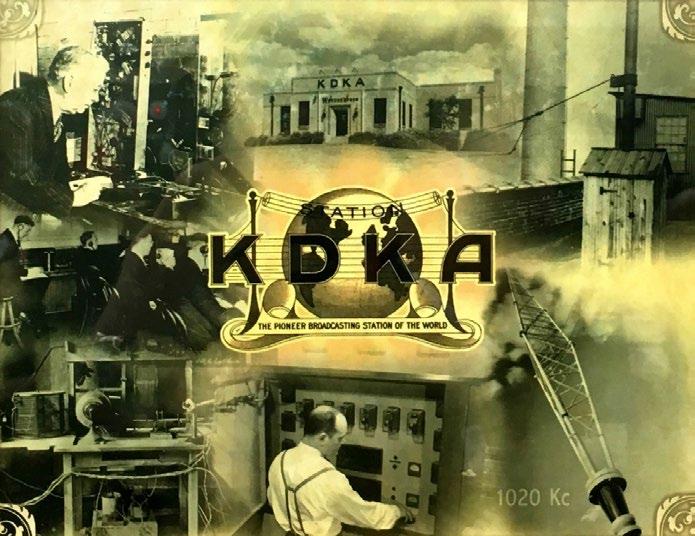
Fig. 3. Frank Conrad. (Courtesy, IEEE History Center)
RADIO PIONEER FRANK CONRAD
Early Years1
Frank Conrad (1874−1941) is best known for his work developing radio technology at the Westinghouse Electrical and Manufacturing Company in East Pittsburgh, Pennsylvania, where he helped establish a foundation for commercial broadcasting (see Fig. 3). His efforts grew from an experimental radio station, 8XK, developed in a workshop he built in the second story of his garage, and his work in establishing Westinghouse’s first broadcasting service over radio station KDKA. Conrad was born in Pittsburgh in 1874, the son of a railroad mechanic and homemaker. Formal schooling ended after he completed the 7th grade. In 1890, he joined Westinghouse at age 16 and registered trains for ampere-hour meter maintenance. He developed reputations for his insatiable thirst for knowledge, work ethic, and incredible memory. In 1897, at age 23, he transferred to Westinghouse’s Testing Department where he invented a circular-type watt-hour meter. Westinghouse promoted him to General Engineer in 1904 and Assistant Chief Engineer in 1921. His work involved arc lighting, ignitions in automobiles, and then radio. He became a member of the American Institute of Electrical Engineers (AIEE) in 1902 and went on to receive more than 200 patents for a variety of electrical devices: 177 in the United States, 42 in the United Kingdom, and 9 in Germany. Conrad’s interest in radio stemmed from a 1913 bet with a co-worker over whose watch was more accurate. Conrad won the bet after he secretly replaced his cheap watch’s internal components with the mechanism from a more expensive and much more accurate watch.2 Conrad then tested the watches, after which he began to question the accuracy of Western Union’s telegraphed time signals. In 1916, he built a simple radio to receive the U.S. Naval Observatory’s time signals, broadcast nightly by station NAA in Arlington, Virginia. Conrad next constructed a transmitter to communicate with his neighbor and other
local amateur radio operators. He then installed a radio station on the top floor of his two-story garage adjacent to his new home in Wilkinsburg, Pennsylvania.3
In July 1916, Conrad’s amateur station received an “Experimental” license, with the call sign 8XK.4 The station included a spark transmitter for Morse code transmissions. The “8” indicated the station was located in the 8th Radio Inspection District, and the “X” designated the station was operating under an Experimental license.
WORLD WAR I
Following the United States’ entry into World War I in April 1917, the U.S. Navy assumed control of the country’s commercial radio stations. All civilian radio stations, including experimental stations like 8XK, were ordered to cease transmission and reception.5 Conrad spent the war years at Westinghouse working on improvements to military radio equipment, including the U.S. Army Signal Corps SCR-69 transmitter and SCR-70 receiver used in airplanes.6 Westinghouse became the first supplier of combination radio telephone-telegraph receivers for the U.S. Navy. Its airborne electrical generator provided power for the first continuous over-water plane-to-shore transmission tests in May 1919 between Newfoundland and England.7 Radio transmitters and receivers designed by Conrad were the only radio equipment to reach the front in considerable quantities for use by the Allied Expeditionary Force.8
Conrad’s work encompassed radiotelephone transmissions (for voice and music, not simply Morse code), and incorporated vacuum tube transmitters. Despite the nationwide blackout for amateur radio transmissions, Conrad received authorization to operate an experimental radio transmitter from his home during the war with the call sign 3WE. He used this station to communicate with a second station located at the Westinghouse plant in East Pittsburgh.9
RADIO BROADCASTING BEGINS
The ban on operating civilian radio stations ended after the war, effective October 1, 1919. Conrad resumed his experiments using the 8XK call sign broadcasting from his home garage, including testing vacuum tube radiotelephone equipment,10 although a formal license renewal was not issued to him until January 21, 1921. Nevertheless, beginning on the evening of October 17, 1919, Conrad began broadcasting selections from his personal collection of phonograph records as he undertook a series of test broadcasts.11 He accepted specific requests to hear records from his growing audience. As the demand grew, he announced that instead of complying with individual requests, he would “broadcast” records for two hours each Wednesday and Saturday evening. KDKA claimed, “This is the first recorded use of the word broadcast to describe a radio service.”12 The debate over this claim is outside the scope of this article, but it can be contested. For example, a January 1917 article in Electrical Experimenter outlined Lee De Forest’s “broadcast” by “radio,” using those words, of U.S. election returns via wireless telephony in November 1916 to 7,000 amateur radio operators who were notified in advance of the scheduled program.13 See further comments below. In any case, in response to his growing audience interest, Conrad adopted a semi-regular schedule of defined programming that was transmitted for all to hear. After exhausting his personal collection of records used to broadcast music, he borrowed records from a local Brunswick record shop in exchange for on-air acknowledgements.14 These on-air acknowledgements constituted the early beginnings of on-air radio advertising. Conrad also ran a telephone line from the music room in his home to the transmitter in his garage, so performers, which included Conrad, could use the family piano.15 These performances constituted the early origins of the on-air radio “studio,” that is to say, a room used as a dedicated performance space whose sounds are broadcast by radio to a listening audience. (Again, the authors of this article have not verified these KDKA claims of providing the first on-air advertisements or first on-air studio.) The Pittsburgh GazetteTimes reviewed Conrad’s radio transmissions, and on December 26, 1919, the New York Times reported “Phonograph’s Music Heard on Radio Phones.” The New York Times estimated Conrad’s audience to be approximately 400 owners of wireless sets. On June 26, 1920, Conrad broadcast a special concert for the patients at the Tuberculosis League Hospital.16
Fig. 4. Harry Davis. (Wireless Age, Apr. 1924)
The Joseph Horne Department Store in Pittsburgh placed an advertisement in the Pittsburgh Sun, “Air Concert Picked Up By Radio,” on September 29, 1920, that offered for sale crystal set radios to hear Conrad’s broadcasts. Harry Davis, a vice president at Westinghouse, noticed the growing popularity of Conrad’s broadcasts and arranged for Westinghouse to build a transmitter at the plant (see Fig. 4). The new Westinghouse station received licensing in October 1920, in time to broadcast results of the upcoming Harding-Cox Presidential Election results on November 2, 1920. (See further discussion below about the timing of the licenses issued to stations KDKA and 8ZZ.)17
Davis envisioned combining radio manufacturing with free radio programming. Listeners could purchase Westinghouse radios specifically to hear free programming provided by Westinghouse in their own homes, thereby creating a readymade market for both the radios and the broadcast programming. Davis had conceived the idea of commercial broadcasting. He invited Conrad to build a transmitter at the Westinghouse plant in Pittsburgh and developed the first formal guidelines for KDKA’s broadcast programming.18 As Davis later explained, “We had in our hands in this idea the instrument that would prove to be the greatest and most direct means of
mass communication and mass education that had ever appeared.”19 Guy E. Tripp, Westinghouse’s Chairman of the Board of Directors, would later state, “Mr. Davis was the only man in the Westinghouse Co. who had the vision of broadcasting and the courage to see it through,” and many Davis obituaries would call him the real “father of broadcasting.”20
Throughout, Conrad continued to conduct experimental radio work. In the summer of 1920, the American Radio Relay League (ARRL) and the U.S. Bureau of Standards began investigating radio signal fading. Variations in signal strength were affecting long distance signals during nighttime operation. Conrad provided testing ideas, and station 8XK was one of the key stations participating in these tests.21 In 1921, Conrad was named assistant chief engineer at Westinghouse and assumed responsibility for all of the company’s radio-related activities.22
KDKA FACILITIES KDKA’s Early Transmitter Frequencies
In the early 1920s, many radio transmitters were rated from 100−150 watts, and approximately 15 were rated up to 1 kW watt with 5−6 rated up to 5 kW. By 1920,
The Radio Club of America Congratulates KDKA on Their Centennial

Although our special centennial tour was cancelled for 2020, please see the RCA website for further information about this historic radio station:
• Interesting videos on KDKA history • Pittsburgh Amateur Radio Club’s KDKA 100th Plans • ARRL’s Special Event for Radio Amateurs for KDKA’s 100th year broadcast anniversary • 3 minute YouTube clip on KDKA history • Detailed excerpt from a broadcasting book, plus biographies on key KDKA persons • Audio clip on the Harding-Cox broadcast on Nov. 2, 1920 • A short early history of wireless including KDKA
https://www.radioclubofamerica.org/awards-banquetand-technical-symposium/ wavelength 360 meters (833.3 kHz) had been allocated by the U.S. government for public broadcasting, near the 600 meters (500 kHz) range used for international distress and experimental uses. By December 1921, a second wavelength of 485 meters (618.6 kHz) had been added for crop reports and weather forecasts. In spring 1922, a third wavelength was added at 400 meters (750 kHz) for Class B stations, which typically operated at 500−1,000 watts. In May 1923, frequencies were reassigned again. As a result, two classes of stations could occupy 500−1,350 kHz: Class A stations transmitting at less than 500 watts (550−800 kHz and 1,000−1,350 watts) and Class B stations using 500 watts or more (870−1,000 kHz) with some older stations still operating at 833.3 kHz. In a series of revisions in April 1927, August 1933, and March 1941, broadcasting allocations were further realigned and now permitted single channel station broadcasting on all frequencies between 550 kHz and 1,600 kHz. This allocation remained in place into the 1990s (see Fig. 5).23
The History of American Broadcasting website analyzed and summarized KDKA’s frequency authorizations by the Federal Radio Commission (FRC) and its successor the Federal Communications Commission (FCC).24
• KDKA made its submission to the FRC, dated October 16, 1920, on Form 761, “Applicant’s Description of
Apparatus.” Form 761 specified that KDKA had two transmitters: a high frequency alternator (3,200 meter set), and a vacuum tube transmitter (500 meter set); both used for code transmissions, and it contained a note that the 500 meter set could also be set up for audio transmissions. • The November 1, 1920 Radio Service Bulletin lists wavelengths of 3,200 meters (93.75 kHz) and 500 meters (600 kHz) for KDKA. At the same time,
Westinghouse was assigned the use of 330 meters for its 8ZZ broadcasts, although the 8ZZ and initial
KDKA broadcasts transmitted on 550 meters for the historic November 2, 1920 broadcast as described below. Westinghouse reports that it transmitted on 330 meters until fall 1921, when Westinghouse’s other stations (KDKA, WBZ, and WJZ) were all assigned to 360 meters at Westinghouse’s request. • The initial license authorized the use of telephone apparatus on 600 meters with 200 watts on October 27, 1920. From October 5−23, 1922, KDKA received authorization to operate on 400 and 485 meters with 600 watts. A series of license modifications in 1922−1923 permitted operations at 360 and 485 meters with 600 watts, 1 kW, and 1.6 kW. In addition
KDKA was granted use of 920 kHz at 500 watts to 10 kW that covered its three transmitters in August 1923.
A temporary permit allowed experimental operations at 970 kHz and 50 kW, and KDKA was authorized to use 1.5 kW of power in 1925. • KDKA applied for additional allocations on April 1, 1927 (see Fig. 6). Licenses were issued in June 1927 permitting operations at 950 kHz and 30 kW as well as 50 kW. In 1928, Westinghouse also received
experimental rights granted at 25 kW, and the main license was reallocated to 980 kHz at 50 kW. • KDKA relocated its main transmitter in 1929.
Subsequent FCC authorizations in 1930 and 1932 granted operations at 980 kHz and 25 kW then 50 kW. In 1941, operations were granted at 1,020 kHz and 50 kW. In sum, at the time of the November 2, 1920 election broadcast, a KDKA license had been signed in October 1920, but Westinghouse had not received it yet. So, Westinghouse requested and was granted the temporary license 8ZZ to use for the broadcast. Westinghouse therefore announced both 8ZZ and KDKA call signs onair.25
KDKA’s Early Transmitters
QST described Conrad’s station 8XK in detail in its September 1920 issue cover story (see Figs. 7 and 8). Fig. 5. Evolution of the standard broadcast band. (Stay Tuned, Sterling and Kittross, 2002, p. 95) Fig. 6. U.S. Federal Radio Commission application record for station KDKA dated Apr. 1, 1927. (Courtesy, FCC) The tour was likely provided by Conrad himself, since the station resided in his home garage. The radio telephone set at the right of Fig. 7 used two 50 watt power tubes, where the plate circuit was supplied by a 1,000 VDC generator, and a 5 watt tube that amplified the audio frequency of the usual direct current generator. The set included two vacuum tubes, operating in parallel, and directly coupled to the antenna inductance. A 700 cycle generator rated at 300 watts supplied the plate circuit, and was driven by a half horsepower induction motor. When adjusted to 250 meters for the Bureau of Standards/ARRL Fading Tests, the set delivered a current of 6.5 amperes to the antenna, with an output of 450 watts. The receiving equipment (not shown in Fig. 7) was typically used for ordinary shortwave reception and comprised a single circuit receiving tuner, which was used in connection with a detector and a two-stage amplifier. The antenna shown includes the counterpoise in place of a ground connection.26
Donald G. Little, the radio engineer who worked as
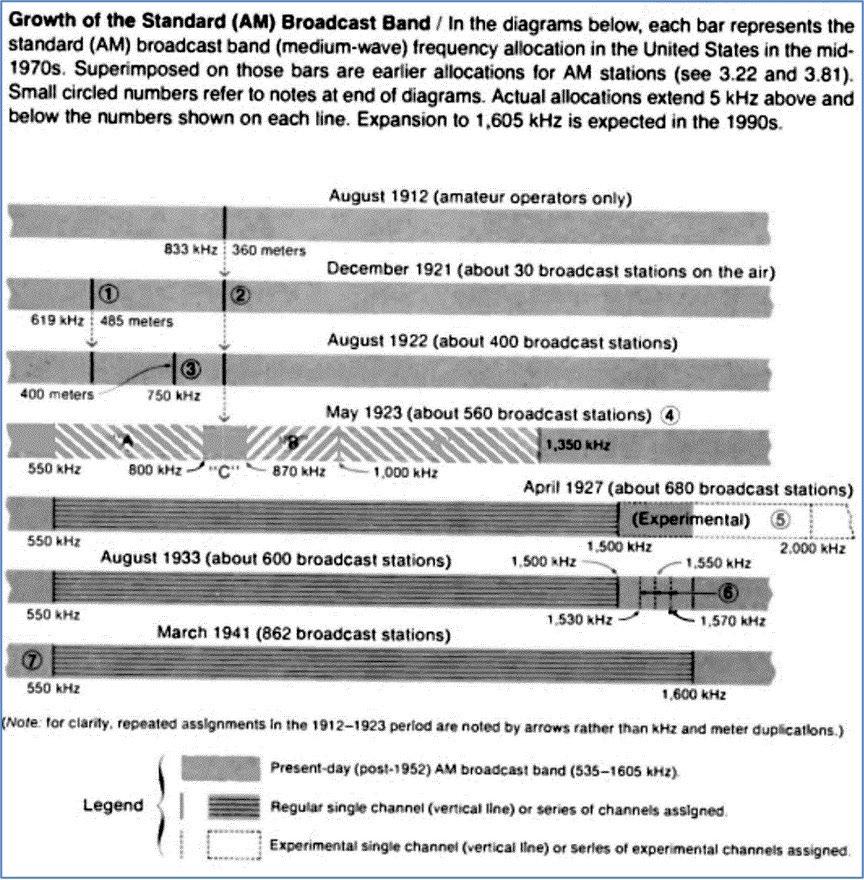
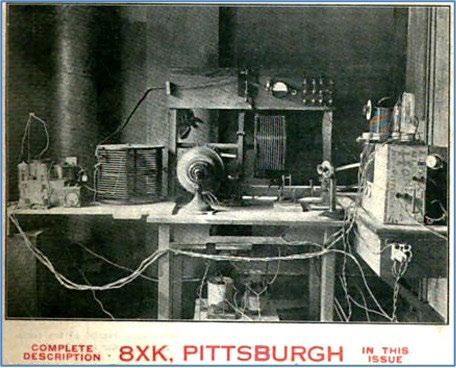
Fig. 7. Frank Conrad’s garage station 8XK appearing on the cover of QST. (QST, Sept. 1920)

Conrad’s assistant at Westinghouse (see Fig. 9), provided
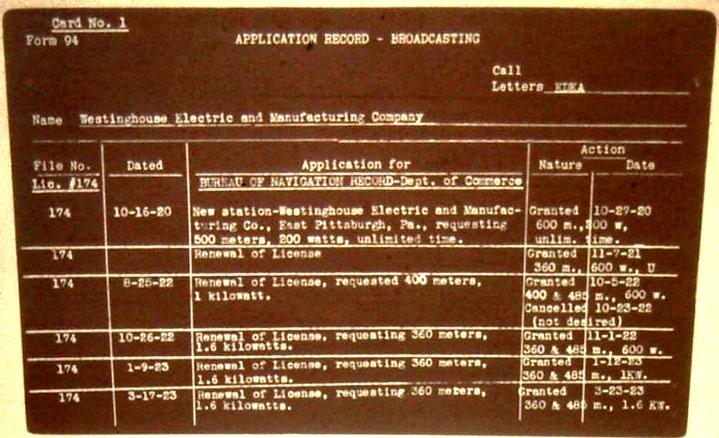
Fig. 8. Frank Conrad’s house, garage, and antenna for station 8XK. (Courtesy, QST, Sept. 1920)
the earliest formal descriptions of the transmitters at KDKA. He published a detailed explanation of the equipment used at KDKA in the September 1922 issue of Radio. 27 Conrad presented a paper about the station on January 2, 1924 at the Convention of the Institute of Radio Engineers (IRE). He subsequently published this paper in the June 1924 issue of Fig. 9. Donald G. Little. the Proceedings of the IRE. 28 (Courtesy, Proc. IEEE, June 1998) Little first joined Westinghouse as a radio engineer after serving in the U.S. Army Signal Corps during World War I. At Westinghouse, he was assigned to serve as Conrad’s assistant. At Conrad’s direction, Little designed and modeled the 1920 KDKA transmitter. Little remained at Westinghouse until his retirement in 1958. He provided numerous firsthand accounts explaining KDKA’s operations in articles published for a wide range of readers.29
In 1922, the KDKA transmitter operated a modulated oscillator of four 250 watt tubes (possibly UV-204 tubes) in parallel modulated by five similar tubes also in parallel. All tubes operated with approximately 2 kV on the plate from a motor-generator set. The radio frequency output was rated at 1 kW.30 This circuit, the Meissner circuit, was being used in experimentation jointly performed with the Radio Laboratory of the Bureau of Standards and Western Electric Company regarding signal fading at various times of day for continuous wave broadcasts at 105 meters.31
By the time Little published his paper describing KDKA in 1924, the station had three complete transmitting sets. Metal water-cooled vacuum tubes acted as rectifiers, modulators, and oscillators. The four rectifier tubes and associated apparatus had a maximum rated output direct potential of 10 kV. Circulating water from a 100 gallon tank placed approximately 20 feet above kept them cool. The tubes used 20−50 gallons of water per hour depending on the power load and resulting heat. The station operated at 920 kHz using an inverted “L” transmitting antenna with a counterpoise (see below). Two outside telephone lines terminating at an operator’s desk provided audio from a studio located at the Pittsburgh Post and another studio located at Westinghouse’s East Pittsburgh plant. In 1923, KDKA’s facilities were considered state of the art.32
Little and a manager at Westinghouse, R. L. Davis, jointly published an updated account of KDKA’s operations in the August 1926 issue of the Proceedings of the IRE where they fully described KDKA’s equipment as of 1926 that was used for both regular and shortwave broadcasting (see Figs. 10–15).33 An interior photograph of KDKA’s shortwave broadcasting station equipment appeared on the cover of the May 1928 issue of QST, but the magazine provided only limited information in a short descriptive paragraph about the station.34
Fig. 10. Control desk of KDKA’s 1926 transmitter station located two miles from the East Springfield Works. (Proc. IRE, Vol. 14, Aug. 1926, p. 502)

Fig. 11. KDKA’s 1926 transmitter and filer control panel. (Proc. IRE, Vol. 14, Aug. 1926, p. 501)
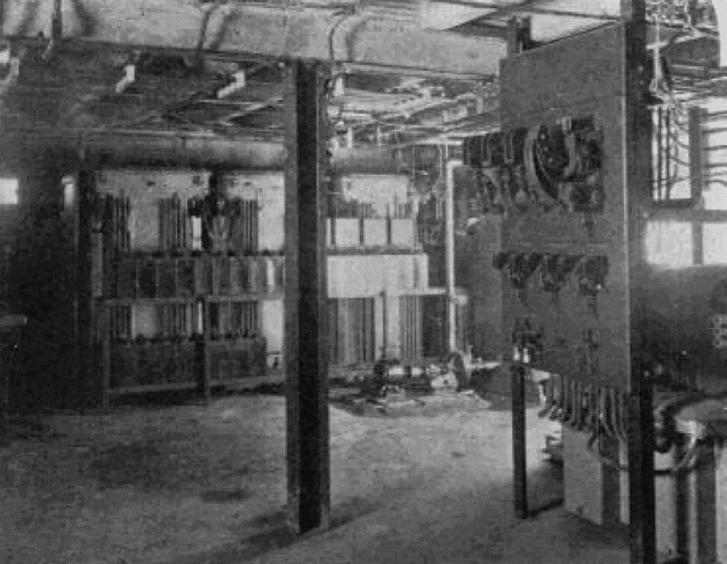
Fig. 12. KDKA’s 1926 No. 1 Transmitter. (Proc. IRE, Vol. 14, Aug. 1926, p. 506)
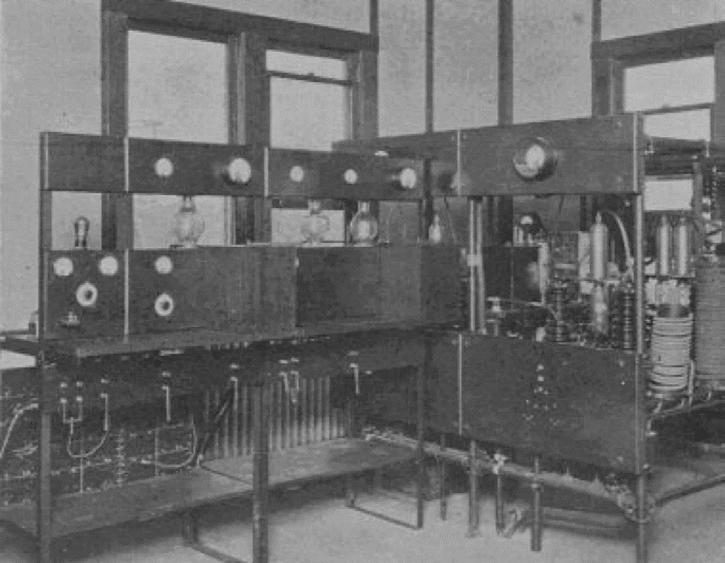
Fig. 13. KDKA’s 1926 transmitter filament motor-generator sets. (Proc. IRE, Vol. 14, Aug. 1926, p. 486)

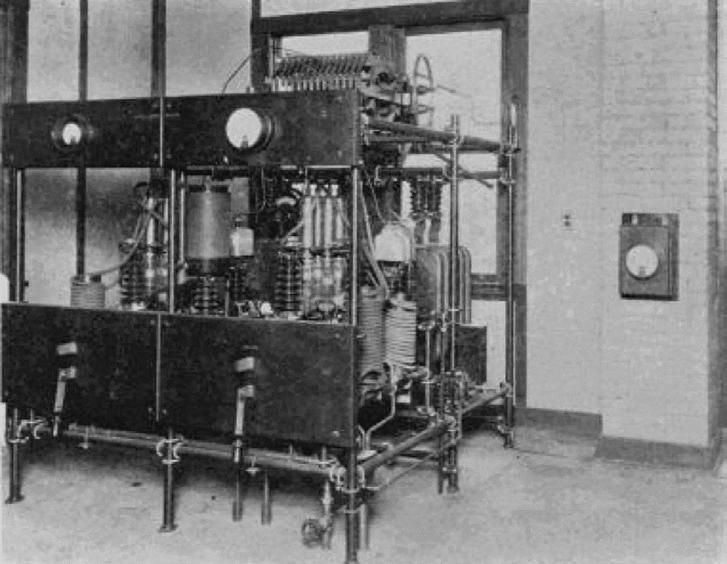
KDKA’s research into signal fading and signal strength eventually contributed towards its rationale for moving its transmitter and antenna tower in 1929. The FRC granted permits in July 1929. The following year, the FRC granted permits for KDKA to operate experimentally on 400 kW, the highest broadcasting power ever attempted up to that time.35
In 1929, KDKA moved its transmitter from East Pittsburgh to a 120 acre site at Saxonburg, Pennsylvania, 26 miles northeast of Pittsburgh. This time, R. L. Davis and another Westinghouse radio engineer, V. E. Trouant, published their description of KDKA’s newest operations used in both regular and shortwave broadcasting in the June 1932 issue of the Proceedings of the IRE (see Figs. 16–18).36
• A 2,600 square foot brick building housed a new transmitter. The antenna sat at some distance away, over a pond, with eight 110 foot high wooden (not metal) poles to limit the signal absorption. The building housed all of the equipment except the rectifier transformers and filter chokes, which sat on a platform at the rear of the building. The wood antenna poles were spaced on a circuit more than 700 feet in
Fig. 14. KDKA’s 1926 970 KHz oscillator frame. (Proc. IRE, Vol. 14, Aug. 1926, p. 485)

Fig. 16. Saxonburg transmitting station in 1932 showing transmitter building. (Proc. IRE, Vol. 20, June 1932, p. 922)
Fig. 15. KDKA’s 1926 transmitter apparatus room. (Proc. IRE, Vol. 14, Aug. 1926, p. 489)


Fig. 17. Saxonburg transmitting station in 1932 showing 40 volt, 1,000 ampere filament motor generators. (Proc. IRE, Vol. 20 June 1932, p. 928)
Fig. 18. Saxonburg transmitting station in 1932 showing AW-220 radio frequency output stage. (Proc. IRE, Vol. 20, June 1932, p. 929)
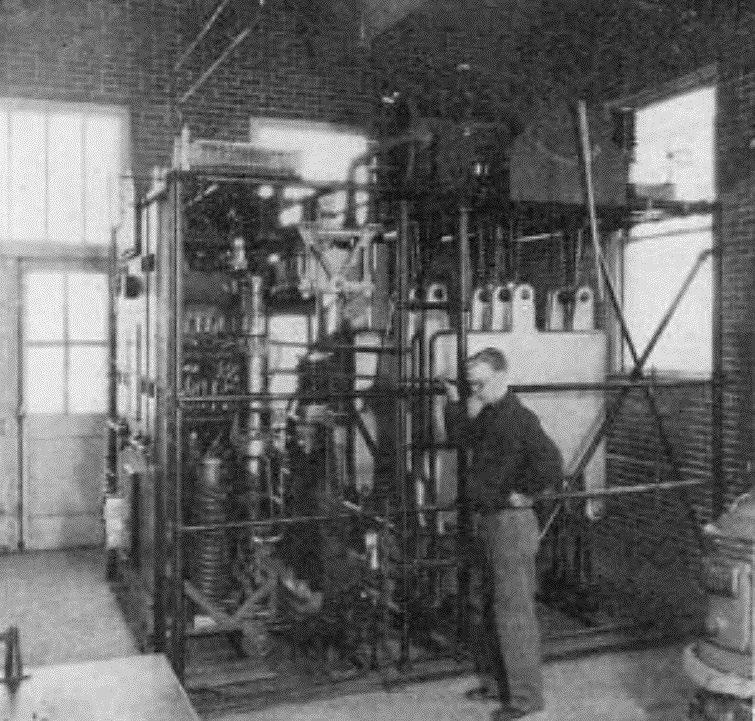
diameter, each with a vertical down lead that was fed from a center point transmission line. The 130 acre site was at 1,300 feet elevation, 100 feet higher than KDKA’s prior transmitter (see below).37
KDKA incorporated six new 100 kW, seven foot tall, eight inch diameter, 60 pound, water-cooled, power supply tubes (AW-220 tubes) that each permitted KDKA to broadcast at 50 kW, half of the power capability. The new tubes, intended for the highest frequency power output, were cooled using soft water pumped to an outdoor cooling pool before being returned to the cooling coils and the tubes. The new tubes replaced the five smaller tubes in operation at the former transmitter. The new Saxonburg facility could produce 400 kW (see Fig. 19).38
Relocation of the antenna tower to Allison Park in 1939 and construction of a new transmitter building brought further changes to the transmitter itself:39

• The new transmitter building was revolutionary.
For the first time, a transmitter station of this size was heated by the same air that was used to cool the giant transmitting tubes. There was no furnace in the building. Air ducts and fins circulated cool air Fig. 19. Saxonburg transmitting about the tubes, and then station’s AW-220 tube. (Radio recirculated the heated News, Apr. 1931)
air throughout the building. Since the station was on the air 18 hours a day, electrical heating units inside the ventilating ducts were able to provide sufficient heat for the remaining hours. • The new transmitter was intended to send out KDKA’s standard broadcasts as well as shortwave programs over the Westinghouse International station WPIT and experimental noise-free shortwave programs from a
“pick-a-back” aerial that was eventually mounted at the top of the main tower. • KDKA’s programs continued to originate from the Grant
Building studios in Pittsburgh that were conveyed to
Allison Park over special high quality telephone lines at an input power of one sixty-millionth of a watt, which were then rebroadcast at 50 kW. • The new KDKA transmitter had a new master control system, which provided a duplicate set of controls for each of three transmitter units. This enabled one operator in a glass enclosed room to simultaneously supervise the programs carried by all three transmitters. The station also had a push button relay shift device that prevented broadcast interruptions caused by burned out tubes when bringing a spare tube into service automatically after one of the six regular tubes became inoperative. At the press of a button, the inoperative tube could be selected and cut out of the circuit, allowing the reserve tube to go into action without loss of station time or danger to transmitter employees.
The Antennas
Conrad employed an inverted “L” antenna at his garage station 8XK that was used in conjunction with a counterpoise in place of a ground connection (see Fig. 8). The flat top of the antenna had six wires, two feet apart, 105 feet long, and 50 feet high. The arrangement permitted operation at shortwave length without the use of a series condenser. It had resistance of 8 ohms at 250 meters.40
Fig. 20. KDKA’s 1920 antenna on Building K in East Pittsburgh. (Courtesy Heinz History Center, Image 20170320-hpichswp-0042)

The original antenna for the 1920 broadcasts from Building K at the Westinghouse plant in East Pittsburgh comprised six wires 190 feet in length on 20 foot spreaders. The antenna sat 210 feet above the ground, supported by the building’s smokestack at one end and a 100 foot pipe mast on the 9 story building at the Fig. 21. KDKA’s 1921 shortwave an- other end (see Fig. tenna on Building K. (Proc. IRE, Vol. 20). A counterpoise, 12, Dec. 1924, p. 726) which duplicated the antenna and replicated a ground connection, was located 110 feet beneath the antenna. This brought the counterpoise about 15 feet below the transmitting set. The high frequency resistance of the antenna system at 360 meters wavelength was approximately 12 ohms, and was mostly radiation resistance. The antenna had current at 500 watts of 6.5 amperes, and at 1 kW had 9 amperes.41
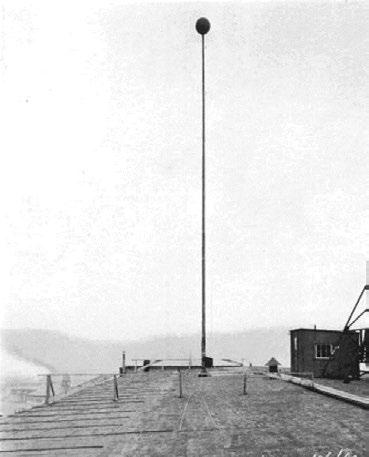
Conrad’s initial shortwave broadcasts in 1921 transmitted from a simple vertical pole mounted on the flat roof of Westinghouse’s Building K. A number of continuous copper strips were fastened to the pole’s surface in order to eliminate high resistance joints in the pole. These strips carried out over the roof at the foot of the pole, forming an extended ground. Conrad replaced this antenna with a vertical L type antenna and a counterpoise to overcome frequent unanticipated frequency shifts (see Fig. 21).42 Conrad designed new versions of oil condensers to handle the high amperages, new inductance coils, and made other circuit and equipment modifications, which successfully raised the upper frequency limits to 3.8 MHz (79 meters) (see Fig. 22).43
Fig. 22. KDKA’s 1921 transmitter unit including rectifiers, modulator, and oscillator. (Proc. IRE, Vol. 12, Dec. 1924, plate after p. 732)
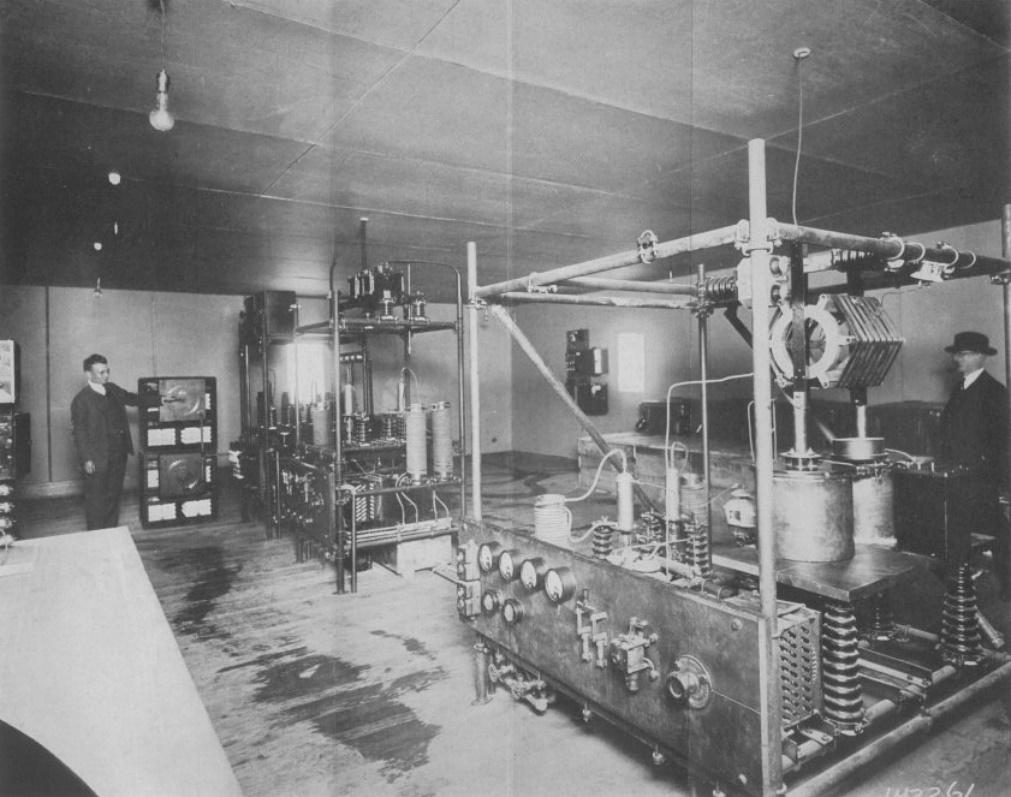
Fig. 23. KDKA’s Saxonburg transmitting station circa 1929 with shortwave antennas shown at the left. (Courtesy Radio News, Feb. 1929)
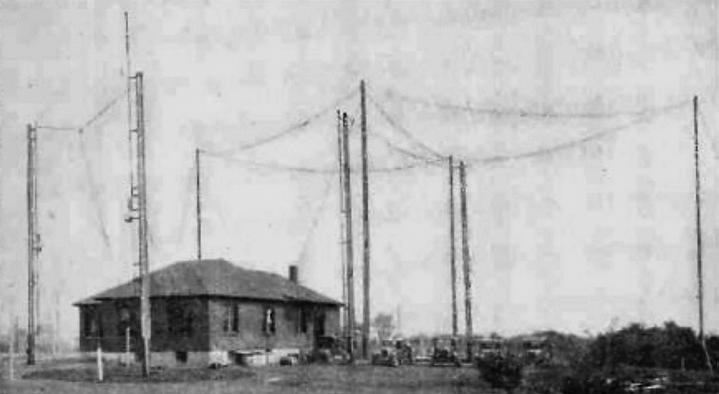
By 1929, KDKA’s shortwave broadcasts reached around the world. The shortwave transmitter occupied the same building as the longwave transmitter that produced signals Fig. 24. KDKA blimp used to lift antenna aerial, at 360 meters. circa 1933. (Courtesy KDKA) The shortwave transmitters operated on 62.50 and 25.40 meters (see Fig. 23).

In April 1933, KDKA used an aerial suspended by a blimp in experiments performed at Saxonburg to help reduce signal fading and to extend the range of the broadcasts by using a 25 foot long, 10 foot diameter, blimp at 1,500 feet altitude to lift 500 feet of antenna wire (see Fig. 24).44
On October 30, 1937, KDKA celebrated its 17th anniversary by dedicating a new 718 foot vertical antenna at Saxonburg. The first antenna installed at 644 feet fell earlier in October. Designs for the new, even taller 1938 antenna included additional wire cabling and forged steel turnbuckles to strengthen the tower’s ability to withstand strains and loads up to 100,000 pounds each.45
KDKA relocated the antenna in 1939 to the highest point in Allegheny County at Allison Park, only eight miles from Pittsburgh, when it also moved the transmitter. The 718 foot tall Truscon antenna located 1,400 feet from the transmitter gave KDKA primary broadcasting service over an area 10 times greater than previous operations. • KDKA placed a circle of eight 90 foot antennas surrounding the 718 foot vertical antenna to suppress interfering radio waves. These 90 foot antennas radiated “skywaves” in opposite directions so that they nullified the effect of the skywaves emitted from the main antenna and extended the fading zone. • The 60 ton structure of the main antenna comprised 32 three-cornered, welded steel sections each five
feet wide, sitting on a 10 foot wide concrete pier. The tower rested in the ball and socket joint of a single large porcelain insulator strong enough to support the additional 20 ton load added by the pull of the guy wires. At 336 feet of height, the antenna was electrically broken by three insulators. The conductivity of the ground was improved by burying 50 miles of copper wire radiating out for 700 feet at one degree apart.46
Cross-arm aerials were also superimposed on the main tower for high frequency transmission, but those broadcasts were limited to 35 miles radius from the tower. The new tower eventually assumed all shortwave broadcasts made over station WPIT (formerly W8XK), which were still operating from Saxonburg in 1939 (see Figs. 25 and 26).47
The antenna tower, at 718 feet, was the tallest welded structure in the world and weighed 60 tons.48 It was also the tallest structure in the U.S., rising 1,900 feet above sea level. The American Bridge Company manufactured the carbon steel, and a team of nine men erected it in 72 hours. Its top 60 foot aviation beacon and lightning rod were level with the roof of the Radio City Building in New York City. Known for its efficiency, it had the strongest signal within its range of any other antenna. It broadcast at a constant 50 kW, the most powerful wattage allowed on the AM airwaves.49
Over the years, the main tower was painted with several layers of orange and white paint so that it would not present a hazard to aircraft. It also was equipped with a 36 inch rotating aviation beacon placed atop a 60 foot cap tower. In 1994, the tower was replaced for structural reasons. The replacement tower that still stands today is also made of carbon steel and resembles the original tower; however, it is equipped with the latest electrical and mechanical technology. The current transmitter and its identical backup system have been online since 1980.50
KDKA opened its FM tower in 1948, operating at 92.9 MHz and transmitted on low band frequency of 47.5 MHz.51 The dual band transition period ended at midnight on January 8, 1949, at which time all low band transmitters had to be shut down, thereby making obsolete 395,000 original FM receivers that had been previously sold and purchased under the original definition of the FM frequency band.52
STATION IDENTIFICATION
Conrad received experimental license 8XK in 1916. He also used station 2WE at the Westinghouse plant in East Pittsburgh and 2WM at his home in Wilkinsburg. By 1919, he was using 8XK for most broadcasting tests. Conrad’s experimental station 8XK provided some voice and music broadcasts by October 1919. Other experimental stations and amateurs occasionally broadcast phonograph music as well, even as early as 1906 (Reginald Fessenden), 1907 (Lee De Forest), and 1909 (Charles “Doc” Herrold). Nonetheless, Conrad is often credited with triggering or inspiring a critical chain of events that helped create the
Fig. 25. View from afar showing KDKA’s Allison Park antenna in 1939. (Broadcasting, Nov. 1, 1939, p. 17)

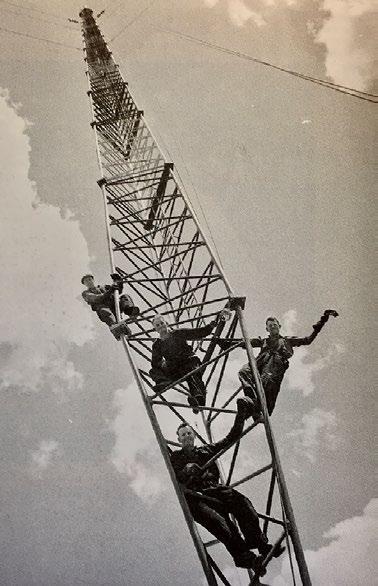
Fig. 26. View from bottom up showing KDKA’s Allison Park antenna in 1939. (Courtesy, Radio News, Jan. 1938; KDKA)
broadcasting industry. (Note, it is outside the scope of this article to fully explore the various claims of who was “first” in radio broadcasting.)53
Evidence from an oral interview of Conrad taken by George Clark circa 1940 indicates that Conrad broadcast “radio concerts” earlier than October 1919 using his special wartime license before he could have been reassigned the 8XK license after the war, possibly as early as April 15, 1919. These broadcasts occurred well before the U.S. ban on radio reception was lifted, and possibly much earlier during experimental testing.54
On November 2, 1920, Conrad operated 8XK from his home as a backup for the broadcasts on KDKA and 8ZZ. Little remained at KDKA serving as the announcer and monitoring the 100 watt transmitter.55 Conrad later recalled in the Clark interview that call sign 8ZZ and KDKA were used interchangeably and that he had also participated as an announcer.56
Arthur Goodnow, the retired Director of Transmitter Engineering for Westinghouse, analyzed government records and reports about KDKA’s licensing history. KDKA began as a Land Radio Station, Class Limited Commercial under a license issued on Oct. 27, 1920 by the Bureau of Navigation of the U.S. Department of Commerce. • The license authorized 500 and 3200 meter transmission and also “300 and 600 meters to be used as required in Regulations 42 and 44,” which meant KDKA was authorized to use 300 meters as a working wave and 600 meters as a calling and distress wave in the maritime service. Power levels were set at 2 kW for radio telegraphy and 200 W for radiotelephony. The KDKA license never mentioned broadcasting, nevertheless KDKA operated the historic
November 2, 1920 broadcast of U.S. election results on 550 meters.
On November 7, 1921, KDKA’s license was modified to include broadcasting on “360 meters to be used exclusively for broadcasting.” The first station in the U.S. to receive an authorization specifically stating, in so many words, that the license was intended for radio “broadcasting” was actually Westinghouse’s second broadcast station, WBZ in Springfield, Massachusetts, which received its authorization on September 21, 1921.57 Although KDKA was not the only station to broadcast election night returns on November 2, 1920 (for example, 9XM/WHA in Madison, Wisconsin, broadcast the results using wireless telegraphy), KDKA claims to be the first station to broadcast regularly scheduled programming, and claims to be the first to engage in “broadcasting” as that term is commonly used today. Thus, KDKA is often acknowledged as the oldest station still in continuous operation.58
Following the opening of WBZ, Westinghouse opened WJZ in Newark, New Jersey, and KYW in Chicago, Illinois, in October and November 1921, respectively.59
As Conrad’s interest in shortwave broadcast experiments grew during 1921−1922, KDKA installed and operated experimental shortwave station 8XS on the rooftop of Westinghouse’s Building K. Beginning July 19, 1923, KDKA began regular nightly 4.5 hour shortwave broadcasts that were soon received across the world.60 In July 1924, the shortwave transmitters were upgraded and relocated to nearby Forest Hills, Pennsylvania. Conrad’s historic call sign 8XK was transferred to the KDKA shortwave transmitter at about this same time.61 By 1927, KDKA shortwave broadcasts on 8XK could be heard most nights at 4.760 MHz.62 Call sign 8XS was returned to the Federal Radio Commission in 1925.63
In November 1927, the FRC held a Washington conference attended by 79 nations and many non-voting organizations. A major accomplishment included the adoption of frequency allocations for most of the broadcast spectrum. It also established that experimental stations would carry country/region prefix in their call signs; i.e., a “W” prefix was added to U.S. experimental station “X” call signs east of the Mississippi River to match the newly agreed-upon international labeling system. Thus, KDKA’s experimental station 8XK became W8XK effective October 1, 1928, in the U.S. and January 1, 1929, internationally.64
A number of other call signs are associated with KDKA. Call sign 8XAU dated from 1924 for use at Westinghouse, which was subsumed into 8XK within the year. Westinghouse used 8XAV for television experiments in the 1920s. Both Westinghouse and the University of Pittsburgh held 8XI during World War I, and it appears to have been a forerunner of 8XK. In 1937, 8XKA received Westinghouse for ultra-shortwave band experiments.65
In subsequent years, frequency locations and broadcasting schedules were revised numerous times. Call signs for a number of experimental stations also changed effective September 1, 1939, including W8XK, which became WPIT.66 Finally, on the corporate side, Westinghouse formed its broadcasting company in the 1920s, known as Westinghouse Radio Stations, Inc., which it subsequently renamed as Westinghouse Broadcasting Company (WBC) in 1954. WBC adopted the “Group W” moniker on May 20, 1963. WBC operated a self-contained entity within the Westinghouse corporate structure. WBC maintained its headquarters in New York City, even though Pittsburgh remained the parent company’s headquarters. WBC operated KDKA. In 1943, WBC stations became affiliates of NBC’s Red Network. WBC eventually built sister stations for FM operations, i.e. KDKA-FM, and for television operations, i.e. KDKA-TV. Today, CBS owns and operates KDKA-TV, and Entercom owns KDKA-AM, while KDKA-FM is owned by Steel City Media.67
KDKA’S STUDIOS
For its first six months, KDKA operated without a studio. All programs originated either as phonograph records played on turntables in the tiny transmitter penthouse atop Building K or from churches, theaters, hotels, or other remote points that were relayed back to the transmitter. In May 1921, KDKA added live band and orchestras to the programming.68
KDKA broadcast its first studio programs from a ninth floor auditorium at the plant, but the microphones picked up excessive sound resonance in the room. So, engineers erected a tent draped with burlap (originally termed “monk’s cloth”) and a single-room shack on the roof next to the transmitter-penthouse. The single room accommodated transmitting equipment, a turntable for records, and KDKA’s first broadcast staff. The performers worked outdoors under the tent. The rooftop tent/studio worked reasonably well until the weather worsened and the tent blew down in a storm. Engineers further developed the use of burlap drapes and acoustical boards after
SPECIAL OFFER TO RCA MEMBERS
CONGRATULATIONS KDKA PITTSBURGH
ON YOUR 100TH
ANNIVERSARY

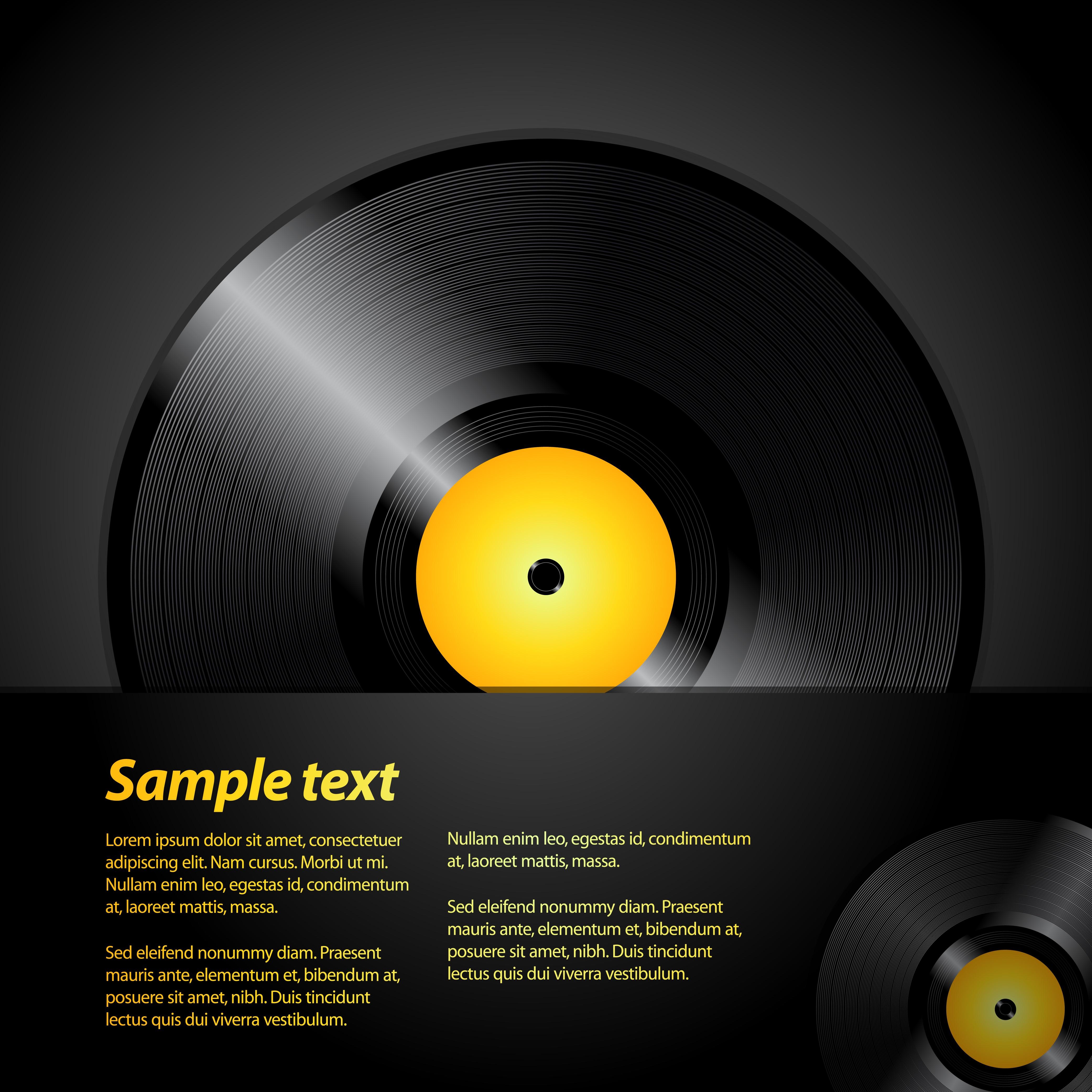
KirmussAudio is proud to participate in restoring your studio’s transcript records made by your staff in the 1960’s. (303) 263-6353 WWW.KIRMUSSAUDIO.COM REG: $970 SPECIAL FOR RCA MEMBERS: $860
BRING LIFE BACK TO YOUR LP’S AND 78 RECORDS!
Others clean, WE RESTORE! IMMEDIATE RESULTS!
For more info: email: ckirmuss@frontier.net
Fig. 27. Cover of Radio Broadcasting News showing new KDKA studio at Building K in December 1922. (Authors’ collection)

constructing an indoor studio the following October in Building K.69 As part of ongoing facility upgrades, a new studio went into operation in December 1922 (see Fig. 27).70
KDKA opened an auxiliary studio in Pittsburgh’s Old Post Building for the convenience of speakers who did not want to travel to East Pittsburgh. The station eventually moved into the ground floor of the Fort Pitt Hotel, occupying two rooms and a bathroom, which housed the control equipment. In January 1929, KDKA opened new studio facilities at the William Penn Hotel.71
The following June, KDKA relocated its master control facilities to the hotel.72 In November 1934, on KDKA’s 14th anniversary, KDKA inaugurated new studios in downtown Pittsburgh’s Grant Building on the third floor.73 The studio included a master control room that relayed the radio signals to the main transmitter site at Saxonburg, location of the 50 kW transmitter (see Figs. 28–30). Twelve years later, in May 1956, KDKA relocated the radio studios to 1 Gateway Center, joining KDKA-TV, where they remained until 2010. That year, KDKA-AM relocated to CBS’s combined radio facility on Holiday Drive in nearby Green Tree, Pennsylvania. KDKA continues to transmit from the Allison Park facility today. Meanwhile, KDKA-TV continued its studio operations at Gateway Center, where it remains today.74
Fig. 28. Floor plan for KDKA studios in the Grant Building circa 1934. (Courtesy Broadcast Pioneers Library)
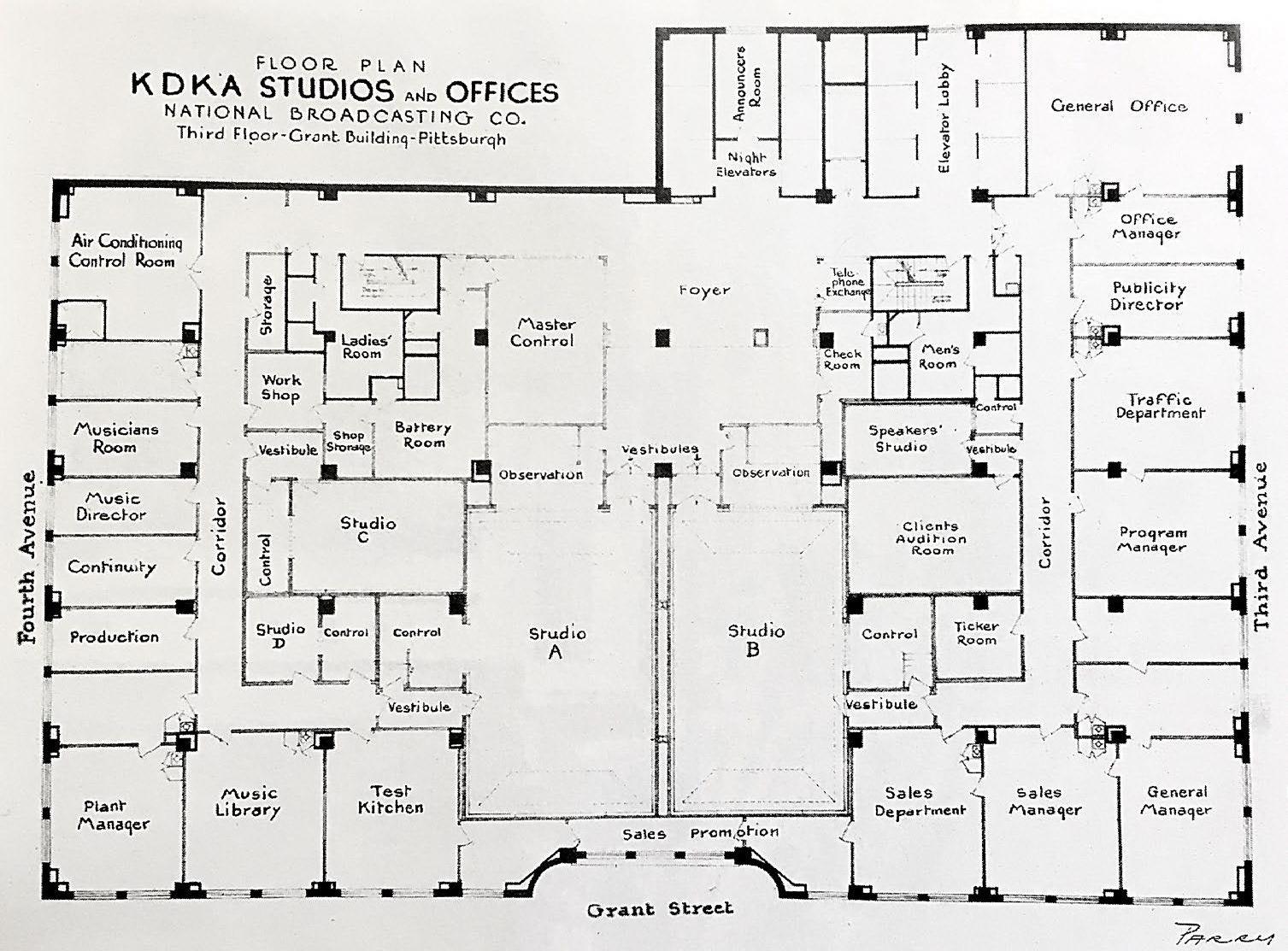
Fig. 29. Control room at KDKA studios in the Grant Building circa 1937. (Courtesy Broadcast Pioneers Library)
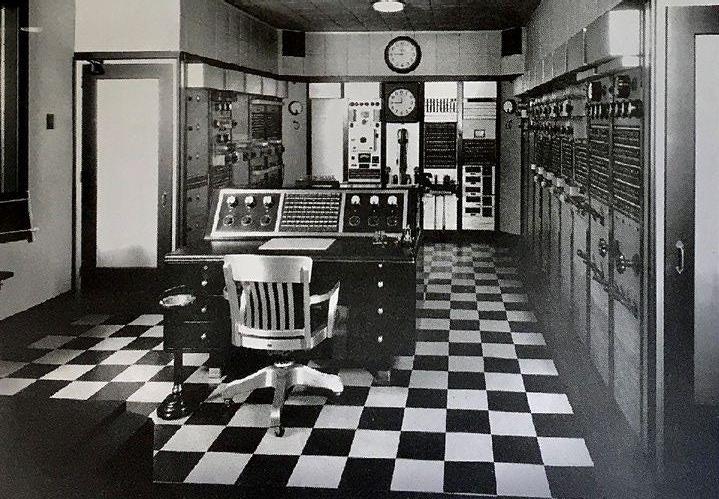
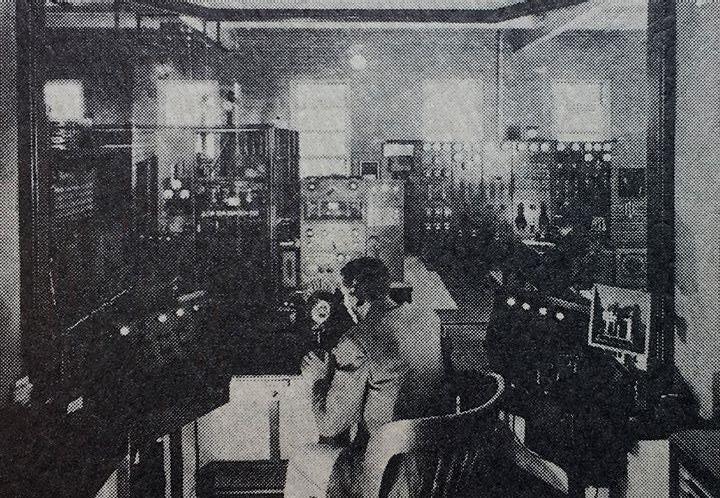
involved determining Based on these and other successful experiments and near the geographic center of the U.S. Westinghouse did not consider KFKX to be an experimental station since much of its design was copied from KDKA’s existing technology and systems. Going forward, much of KDKA’s research efforts centered and reception. Experiments
the precise carrier wave frequencies that would give the maximum constant strength of signal, especially during high listenership broadcast hours. KDKA maintained a 100 meter shortwave transmitter antenna, only 35 feet long, atop Building K in East Pittsburgh (see Fig. 31).76
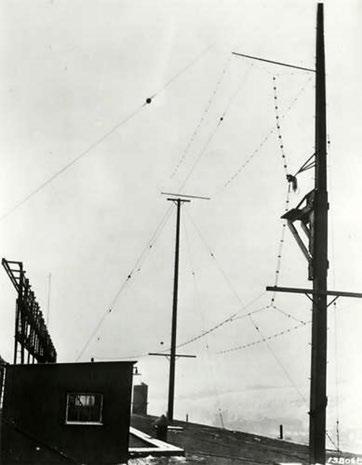
Recognizing the success of KDKA’s shortwave broadcasts from Pittsburgh Fig. 31. KDKA’s 100 meter shortwave antenna on Building K. (Courtesy Heinz History Center, Image and the establishment 20170320-hpichswp-0059) of KFKX as a repeating station, the newly formed British Broadcasting Company (BBC) established a private high frequency receiver in Manchester, England, to perform tests of its own with KDKA and KFKX. This led to the BBC’s own shortwave broadcasts by December 29, 1923, that were linked to KDKA. On December 31, 1923, Davis broadcast a New Year greeting speech to the people of Great Britain.77
Over subsequent years, Westinghouse expanded its operations at KDKA, as told in numerous firsthand accounts and in other publications.
Fig. 30. Transmitter control room at Saxonburg circa 1937. (Courtesy KDKA) In its first decade, KDKA achieved a string of successes and received national and international attention from those accomplishments. For example, a brief survey of just the New York Times highlights:78
December 21, 1923 — Boy In Belfast Picks Up KDKA. KDKA’S FIRST DECADE February 10, 1924 — Mountains Cause KDKA’s Music Frank Conrad’s initial experiments focused on 100 meter shortwave broadcasting between KDKA and amateurs “wave trap” placed between the antenna and ground). living in the Pittsburgh area. In 1922, Conrad successfully March 16, 1924 — Sextet of Stations Broadcast Over A demonstrated shortwave radio reception while at an Span of 7,000 Miles (see Fig. 32). International Radio Conference held in London where April 20, 1924 — Pittsburgh Programs Relayed To the audience heard broadcasts from station 8XK.75 England on Short Waves. demonstrations, Westinghouse installed a second receiving March 29, 1925 — Transmitter On A Truck Relays and broadcasting station, KDPM, in Cleveland, Ohio. Programs To KDKA. Two years later, in 1923, Westinghouse opened station October 5, 1924 — Short Waves To Link 62 Banquets KFKX at Hastings, Nebraska, and claimed it to be the (10,000 diners in America and England heard President world’s first repeating station. It was specifically located Coolidge broadcast from the White House) (see Fig. 33). on shortwave transmitting Fig. 32. KDKA’s international broadcasting system. (Courtesy New York Times, Mar. 16, 1924) to Swing And Fade (the development of a filter circuit or

April 20, 1925 — Australia Hears KDKA. June 7, 1925 — Low Aerial On Hill Radiates Further And Waves Fade Less (explained signal strength and the theory of fading). May 14, 1927 — Devise New System of Broadcasting (how 1,900 stations can operate simultaneously on KDKA’s new 500 Hz signal separation system). November 29, 1927 — Test Short Waves To Attune Stations (how KDKA and KYW of Chicago tested synchronized chain broadcasting). January 6, 1929 — KDKA Program Reaches Top and Bottom of World (Christmas broadcast to the Admiral Byrd Expedition at the South Pole and the Canadian outpost near the North Pole). January 9, 1929 — Radio to Byrd Improves. January 22, 1929 — Dual Broadcasting System Invented By Pioneer at KDKA (described the Conrad patents permitting one microphone to serve two transmitters simultaneously). February 24, 1929 — KDKA Rebroadcasts Big Ben Time Signal. September 5, 1929 — New Distance Record Set By Radio Program (KDKA’s report of the Graf Zeppelin blimp’s arrival in Lakehurst, New Jersey, as heard by Admiral Byrd’s ship in New Zealand). In January 1925, ARRL held a Tri-State Convention in Pittsburgh and included a special tour of KDKA to see the 63 meter transmitter.79 ARRL returned in June 1927 for its Atlantic Division Convention. This time, Bell Telephone Company and Westinghouse teamed up to provide tours of the telephone exchange and the station facilities at KDKA.80 The IRE held their 20th anniversary convention in Pittsburgh in August 1932 at the William Penn Hotel, once the location of KDKA’s earliest radio studios. Again, exhibits and programs featured KDKA as a major attraction. Bus tours brought participants to see KDKA’s current and historic locations at the Westinghouse plant and the Saxonburg transmitter station.81
Throughout, 8XK, W8XK, and KDKA issued confirmations and other correspondence with listeners from the general
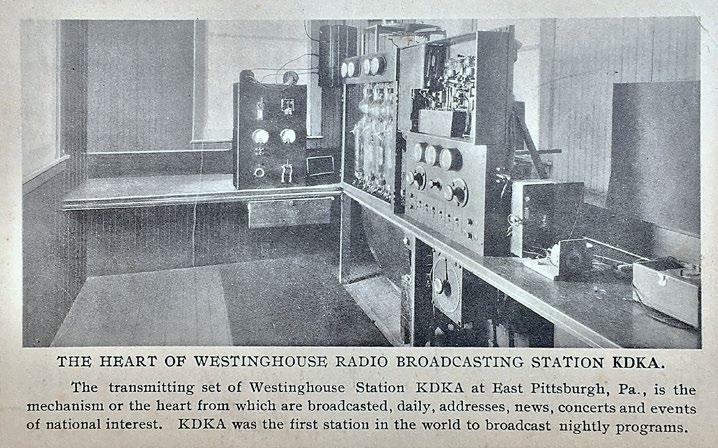
Fig. 33. Shortwave receivers installed at 62 banquets by KDKA. (Courtesy New York Times, Oct. 5, 1924)

public and amateur radio followers. Beginning the night of the initial November 1920 broadcast, KDKA announced a familiar request to the radio audience, “Will anyone hearing this broadcast communicate with us, we are anxious to know how far the broadcast is reaching and how it is being received.”82 Written contacts were made by sending post cards, station letters, and amateur radio QSL card mailings to verify radio contacts and signal strengths (see Figs. 34–37). FRANK CONRAD’S LATER YEARS83
Conrad continued performing groundbreaking radio research throughout his life. For example, he investigated transmitter harmonics, the unwanted additional radio signals produced at higher frequencies than a station’s normal transmission frequency. He unexpectedly found that harmonics could be heard farther than the primary signal in some instances. This work initially led Westinghouse to evaluate the commercial potential of shortwave transmissions. In 1924, Conrad showed Radio Corporation of America’s (RCA) then vice president and general manager, David Sarnoff, that low-powered shortwave signals from East Pittsburgh could be received in London using a simple receiver with a curtain rod as an antenna. This matched the results obtained, at a small fraction of the cost, from RCA’s method for transatlantic radio using the massive longwave Alexanderson alternator transmitters at RCA Radio Central located on Long Island.
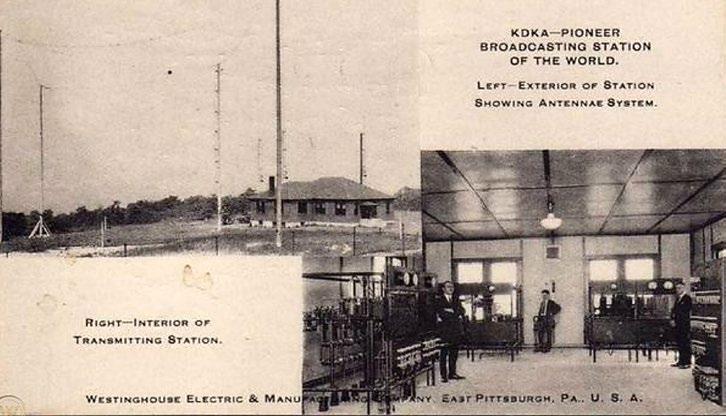
Fig. 36. Reception verification card: 1929 W8XK QSL. (Authors’ collection)

Fig. 37. Reception verification card showing antennas and interior of building: 1960s KDKA QSL. (Flickr)
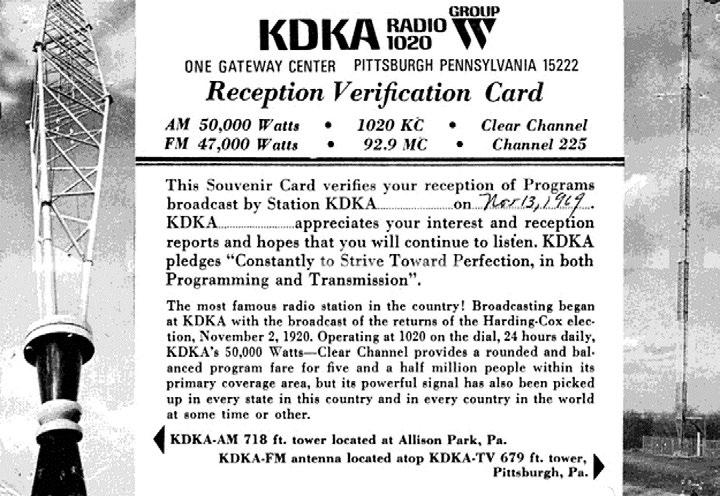
RCA’s transmitters produced signals that were sent and received using horizontal antennas with lengths measured in kilometers.84
Conrad’s last license for 8XK expired November 3, 1924. Westinghouse re-designated the call sign of a different experimental station in East Pittsburgh from 8XAU to 8XK in December 1924. Thus, the historic 8XK call sign continued to be heard worldwide as part of Westinghouse’s shortwave transmission tests.85
In 1928, Conrad demonstrated a movie film-to-television converter at Westinghouse, and he also researched narrowband FM transmissions.86
Conrad retired from Westinghouse in 1940. He suffered a heart attack the following year on November 6, 1941, while driving to his winter home in Miami, Florida. He died there on December 10, 1941.87
Conrad shared his research publicly from the start. From the beginning, he provided a description of his home garage station 8XK to QST in its cover story for the September 1920 issue. He presented a comprehensive description to the Radio Club of America in a presentation entitled “Description of Radio Station 8XK” in September 1921.88 These were followed by numerous other firsthand descriptions of station 8XK and KDKA over the years. Conrad became widely acclaimed as a father of radio broadcasting. He was featured on the cover of the June 1930 issue of RadioCraft as one of the “Men Who Made Radio” (see Fig. 38). He served on the Advisory Technical Committee of the ARRL in 1923, as reflected in the issues of QST published that year. He was very active in the AIEE and the IRE, where he published numerous articles about his research. Starting as a self-made man with a seventh grade education, in 1928, Conrad Fig. 38. Frank Conrad on the cover of Radio-Craft. (Radio-Craft, June 1930) received an honorary Doctor of Science degree from the University of Pittsburgh in recognition of his many contributions. He received numerous awards for his work, including:89
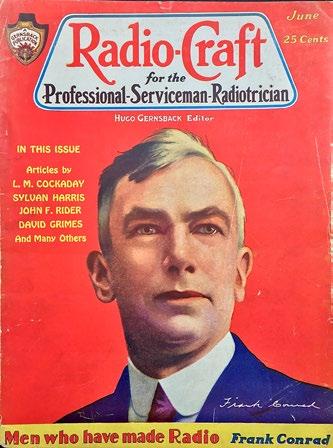
• Liebmann Award (1925) from the IRE for his research on high-frequency radio receivers and shortwave transmission. • Fellow, IRE (1927). • Vice President, AIEE (1927) and Chair of the
Committee on Admissions (1927). • Edison Medal (1930) from the AIEE for his contributions to radio broadcasting and shortwave radio transmission. • Scott Medal (1933) from the city of Philadelphia for inventions that improved the comfort, welfare, and happiness of humankind. • Lamme Medal (1936) from the AIEE for pioneering and basic developments in the fields of electric metering and protective services. • Fellow, AIEE (1937). • Gold Medal (1940) from the American Institute of the
City of New York. • Member of the Society of Automotive Engineers. • Member of the American Association for the
Advancement of Science. • IEEE Electrical Engineering Hall of Fame (2007).
LEGACIES
KDKA considers itself “the pioneer broadcasting station of the world” and the “world’s first broadcasting station.”90 As Davis later explained, by design and intent, Westinghouse and KDKA “endeavored to render a real public service, with regularity, presenting well-planned, high-grade, interesting, and timely advertised programs.”91 Note, KDKA’s claims pertain to a nuanced view of the word “broadcasting” that includes programming management and public announcements of that programming. It lies outside the scope of this article to verify or debate those claims. Other authors have surveyed these issues and
KDKA’s promotional literature and its management state their views of the station’s many firsts:93
• First commercial broadcasting studio. • First church service. • First broadcast from a hotel. • Herbert Hoover’s first radio address. • First presidential inaugural address (President
Harding). • First broadcast from a theater. • First symphonic music played on the air. • First sports broadcast (boxing match between Johnny
Ray and Johnny Dundee). • First heavyweight boxing match broadcast (Jack
Dempsey knockout of Georges Carpentier). • First broadcast of a tennis match. • First regular government farm reports. • First radio newsroom (linked to the Pittsburgh Post). • First full time professional radio announcer and sportscaster (Harold Arlin). • First radio broadcast of comedian (Will Rogers). • First baseball game broadcast (Pittsburgh Pirates beat the Philadelphia Phillies). Yet, KDKA’s historic 1920 broadcast was hardly mentioned in newspapers and magazines at the time. “The sensation in the public press created by this marvelous demonstration of wireless telephony”94 would not begin to be recognized outside of Pittsburgh until May 1921 (QST and Scientific American) and July 1921 (Literary Digest).95 Today, the legacies of KDKA and its predecessor 8XK are both celebrated. David Sarnoff, RCA’s legendary president, proclaimed Frank Conrad to be “a man respected and admired throughout the electrical and radio industries, a benefactor of humanity and my friend.”96
Conrad and Westinghouse’s stations, along with other experimental stations and early broadcasters, transformed radio from an amateur technologist’s hobby to a broad, easily accessible, national pastime. Their work contributed to the conversion of radio from the use of small crystal receivers and personal transmitters issuing point-to-point communications into a voice driven medium cast upon the airwaves for all to listen.
ABOUT THE AUTHORS
David Bart is a fellow, director, and life member of both RCA and the Antique Wireless Association and chair of the RCA Publications Committee. He is treasurer of the IEEE History Committee, and vice president of the Museum of Broadcast Communications in Chicago. Julia Bart is an advisor to and a fellow of the AWA, a former officer of the Antique Radio Club of Illinois, and coauthor of numerous articles with David.

2020 TECHNICAL SYMPOSIUM AND 111TH AWARDS PROGRAM SATURDAY, NOVEMBER 21, 2020 VIRTUAL
“Who’s Who in Amateur Wireless,” QST, Feb. 1921, p. 39; “Radio−Trick Watch: First Radio Broadcasting Followed Founder’s Time Wager in Pittsburgh,” Literary Digest, Mar. 13, 1937, p. 19; D. W. Kraeuter, “A Bibliography of Frank Conrad,” (3rd ed., 2007) National Museum of Broadcasting, http://www.nmbpgh.org/cbib/conradbibl.htm; “Personalities in Industry: Frank Conrad,” Scientific American, Vol. 157, No. 5, Nov. 1937, p. 259; E. Barnouw, A Tower in Babel: A History of Broadcasting in the United States to 1933, (New York: Oxford University Press, 1966) p. 64−74 citing D. G. Little, Reminiscences, Unpublished, (New York: Columbia University Oral History Collection, 1951); “Correspondence Regarding H. P. Davis’ Nomination of Frank Conrad for the Lamme Medal dated Oct. 13, 1928, IEEE Archive, https:// ethw.org/w/images/3/35/Conrad_- correspondence_regarding_ lamme_medal.pdf. “Radio Pioneer’s Bet A Trick, Widow Says,” Pittsburgh Press, Sept. 7, 1957, p. 2. “Frank Conrad: Sleepless Genius,” National Museum of Broadcasting, http://www.nmbpgh.org/conrad_project/ historical_background/conrad.htm. “New Stations: Special Land Stations,” Radio Service Bulletin, Aug. 1, 1916, p. 3. Barnouw, 1966, pp. 39−41, 61. D. G. Little, “Dr. Conrad Founds KDKA,” American Heritage, Aug. 1955, p. 71; “Electrical Engineering Hall of Fame: Frank Conrad,” IEEE, Proceedings of the IEEE, Vol. 95 No. 6, June 2007, p. 1378. It Started Hear: The History of KDKA Radio and Broadcasting, KDKA booklet, 1970, p. 4; https://www. americanradiohistory.com/Archive-Station-Albums/It-StartedHear-KDKA.pdf. “Men Who Have Made Radio−Frank Conrad,” Radio-Craft, June 1930, p. 631. G. Gray, “Signing Off on the First Ten Years”, World’s Work, Dec. 1930, p. 46; Wenaas, E., Radiola: The Golden Age of RCA 1919−1929, (Chandler, AZ: Sonoran, 2007) p. 68−71 and p. 124, Note 12. Experimental License number 236½, call sign 8XK, covering Jan. 21, 1920−Jan. 20, 1921. Conrad may have received informal authorization to operate pending the license reissuance. QST reported that radio Inspectors were authorized to permit radio operators to resume transmissions using their official call without waiting for receipt of the actual license (“Getting Your Licenses”, QST, Nov. 1919, p. 12). C. E. Urban, “The Radio Amateur—Wireless Telephone Here”, Pittsburgh Gazette Times, Oct. 26, 1919, Sixth Section, p. 13. It Started Hear, 1970, p. 4. “Election Returns Flashed by Radio to 7,000 Amateurs,” Electrical Experimenter, Vol. IV, Whole No. 45, No. 9, Jan. 1917, p. 650. Gray, 1930, p. 47. C. E. Urban, “The Radio Amateur,” Pittsburgh Gazette Times, May 2, 1920, 6th Section, p. 4; Barnouw, 1966, p. 67; Little, 1951. C. E. Urban, “The Radio Amateur,” Pittsburgh Gazette Times, July 4, 1920, 2nd Section, p. 5. “Electrical Engineering Hall of Fame: Frank Conrad,” Jun. 2007, p. 1378. H. P. Davis, “The Early History of Broadcasting in the United States,” The Radio Industry The Story and Its Development As Told by Leaders of the Industry to the Students of the Graduate School of Business Administration George F. Baker Foundation Harvard University, (Chicago & New York: A. W. Shaw Company, 1928) pp. 189−225. G. Archer, History of Radio to 1926, (New York: The 20
21
22
23
24
25 26 27
28
29
30
31
32 33
34
35
36
37
38
39
40 41 42
43 44 American Historical Society, Inc., 1938) p. 201; Davis, 1928, pp. 189−225. A. Balk, The Rise of Radio From Marconi Through The Golden Age, (Jefferson, NC: McFarland & Co., 2006) pp. 34−39; Davis, 1928, pp. 189−225. S. Kruse, “The Bureau of Standards−ARRL Tests of Short Wave Signal Fading,” QST, Part I: Nov. 1920, p. 5 and Part II: Dec. 1920, p. 13. “Electrical Engineering Hall of Fame: Frank Conrad,” June 2007, p. 1378. C. H. Sterling and J. M. Kittross, Stay Tuned: A Concise History of American Broadcasting, 2nd ed., (Belmont, CA: Wadsworth Publishing, 1990) pp. 83−89; for a more comprehensive discussion, see also M. R. Bensman, The Beginning of Broadcast Regulation in the Twentieth Century, (Jefferson, NC: McFarland & Co., 2000). “History of KDKA, Pittsburgh,” History of American Broadcasting website, http://jeff560.tripod.com/kdka.html citing FCC microfiche files on KDKA as transcribed by Xen Scott and G. Douglas, The Early Days of Radio Broadcasting, (McFarland & Company, Inc., 2001); see also Bensman, 2000, pp. 75, 130−131, 181. Ibid. “8XK, Pittsburgh, PA,” QST, Sept. 1920, p. 32. D. G. Little, “Radio Equipment at KDKA,” Radio, Vol. IV, No. 9, Sept. 1922, pp. 29−31, 90−94. D. G. Little, “KDKA: The Radio Telephone Broadcasting Station of the Westinghouse Electric and Manufacturing Company at East Pittsburgh, Pennsylvania,” Proceedings of the IRE, Vol. 12, No. 3, June 1924, pp. 255–276. M. A. Simaan, “An Introduction to D. G. Little’s 1924 Classic Paper ‘KDKA,’” Proceedings of the IRE, Vol. 86, No. 6, June 1998, p. 1273; Little, Aug. 1955, pp. 71–73. “KDKA 1922,” Old Timer’s Bulletin, Antique Wireless Association, Vol. 11, No. 1, June 1970, p. 17. S. R. Winters, “100-Meter C.W. Transmission,” Radio News, Nov. 1923, p. 530. Simaan, June 1998, p. 1273; Little, June 1924, p. 255. D. G. Little and R. L. Davis, “KDKA,” Proceedings of the IRE, Vol. 14, No. 4, Aug. 1926, p. 479. “The Short-wave Broadcasting Station at KDKA, East Pittsburgh,” QST, May 1928, cover and p. 43. “Sets 400,000 Watt Permit,” New York Times, Aug. 31, 1930. R. L. Davis and V. E. Trouant, “Westinghouse Radio Station at Saxonburg, Pa,” Proceedings of the IRE, Vol. 20, No. 6, Jun. 1932, p. 921. Davis and Trouant, June 1932, p. 921; “Permit Given To Move 2 Radio Transmitters,” New York Times, July 12, 1929; A. Pfaltz, “KDKA Radio’s New 500 Horsepower Voice,” Radio News, Apr. 1931, p. 873. Davis and Trouant, June 1932, p. 921; R. L. Davis, “Power Equipment at New KDKA Station,” Transactions of the AIEE, Vol. 31, No. 3, Sept. 1931, p. 942 (also published in Electrical Engineering, Vol. 50, No. 11, Nov. 1931, p. 865); “Powerful New Tube For KDKA’s Voice,” New York Times, Aug. 11, 1929; A. Pfaltz, “KDKA Radio’s New 500 Horsepower Voice,” Radio News, Apr. 1931, p. 873. “KDKA Opens Transmitter”, NBC Transmitter, Vol. 5, No. 12, Dec. 1939, p. 8; “The New KDKA Is On The Air,” New York Times, Nov. 5, 1939; “Gala Program for KDKA Anniversary,” Broadcasting, Nov. 1, 1939, p. 17. “8XK, Pittsburgh, PA,” Sept. 1920, p. 32. “KDKA,” Wireless Age, Aug. 1922, p. 40. F. Conrad, “Short-wave Radio Broadcasting,” Proceedings of the IRE, Vol. 12, No. 6, Dec. 1924, pp. 723−738. Ibid. “Blimp to Hold KDKA Aerial,” New York Times, Apr. 2, 1933; “Blimp Antenna Will Be Installed at KDKA,” Broadcasting, Apr. 1, 1933, p. 16.
“Seventeen Years of Broadcasting (KDKA Installs Tallest Antenna),” Radio News, Jan. 1938, p. 391. KDKA’s 17th Birthday party: Pittsburgh Station Celebrates With Dedication of New 718-Foot Vertical Antenna,” Broadcasting, Nov. 1, 1937, p. 18; “KDKA Takes Air Nov. 1 With New Transmitter,” Broadcasting, Nov. 1, 1937, p. 71; “New Antenna to Multiply Field”, Radio Craft, Jan. 1938, p. 391. “The New KDKA Is On The Air,” New York Times, Nov. 5, 1939; “Seventeen Years of Broadcasting (KDKA Installs Tallest Antenna),” Radio News, Jan. 1938, p. 391. “Did You Know?,” Radio Daily, Nov. 4, 1937, p. 6.; “Seventeen Years of Broadcasting,” Radio News, Jan. 1938, p. 391. “Seventeen Years of Broadcasting,” Radio News, Jan. 1938, p. 391; “KDKA Opens Transmitter,” NBC Transmitter, Vol. 5, No. 12, Dec. 1939, p. 8; “Gala Program for KDKA Anniversary,” Broadcasting, Nov. 1, 1939, p. 17. D. A. Schecter, “KDKA’s Toppled Tower Lives in Lucite – Pittsburgh Hospital Is Beneficiary”, Antique Radio Classified, Vol. 13, No. 3, Mar. 1996. “New KDKA-FM Tower,” Broadcasting, June 21, 1948, p. 75. “395,000 FM Radio Sets Must Be Replaced,” Journal Gazette, June 27, 1945, p. 6. J. S. Berg, The Early Shortwave Stations: A Broadcast History Through 1945, (Jefferson, NC: McFarland & Co., 2013) p. 13, 20; Balk, 2006, pp. 34−39; J. E. Baudino, J. M. Kittross, “Broadcasting’s Oldest Stations: An Examination of Four Claimants,” Journal of Broadcasting, Vol. 21, No. 7, Winter 1997, p. 61; D. Clark, “WHA Madison-Is It Really The Nation’s Oldest Station?,” AWA Review, Antique Wireless Association, Vol. 28, 2015, p. 252; Balk, 2006, pp. 34−39; Archer, 1938, p. 88. Wenaas, 2007, pp. 68−71; citing “The Story of Conrad and Station KDKA,” Dictated to H. G. Clark by Dr. Conrad and W. W. Rogers in Pittsburgh about 1940, George H. Clark Radioana Collection 1880−1950, Smithsonian Institution National Museum of American History, SRM 4 1559. Little, Aug. 1955, p. 71. Supra Note 51, pp. 72−73; J. S. Berg, The Early Shortwave Stations: A Broadcast History Through 1945, (Jefferson, NC: McFarland & Co., 2013) p. 21. A. C. Goodnow, “KDKA’s First Wavelength,” Old Timer’s Bulletin (Antique Wireless Association) Vol. 15, No.1, June 1974, p. 21. Supra Note 50. Davis, 1928, pp. 189−225. J. S. Berg, The Early Shortwave Stations: A Broadcast History Through 1945, (Jefferson, NC: McFarland & Co., 2013) p. 23. Berg, 2013, p. 36. Berg, 2013, p. 57. J. S. Berg, On the Short Waves, 1923−1945: Broadcast Listening in the Pioneer Days of Radio, (Jefferson, NC: McFarland & Co., 2009) p. 48; “Shortwave KDKA and its Many Callsigns and Transmitters,” Shortwave Central, Teak Publishing, Oct. 19, 2016, http://mt-shortwave.blogspot. com/2016/10/shortwave-kdka-and-its-many-callsigns.html. Berg, 2013, p. 60. “Shortwave KDKA and its Many Callsigns and Transmitters,” Shortwave Central, Teak Publishing, Oct. 19, 2016. Berg, 2013, p. 186; for a more extensive discussion of frequency regulation and authorizations see Bensman, 2000. “Westinghouse Broadcasting,” Wikipedia, https:// en.wikipedia.org/wiki/Westinghouse_Broadcasting#Radio_ origins. It Started Hear, 1970, p. 10; Davis, 1928, pp. 199−201. Ibid. Cover illustration, Radio Broadcasting News, Dec. 30, 1922, p. 1. 72 73
74
75
76
77
78
79
80
81
82 83 84 85 86
87
88
89
90 91 92 93
94 95 96 S. H. Steinhauser, “KDKA Set to Sign Off and Move From Studios Atop William Penn,” Pittsburgh Press, Nov. 1, 1934, p. 30. “Studio Control,” Pittsburgh Press, June 25, 1929, p. 44. S. H. Steinhauser, “Engineers Test New KDKA Plant with Station Founder Listening,” Pittsburgh Press, Oct. 29, 1934, p. 24; “KDKA Memories: Celebrating 95 Years of KDKA Radio”, KDKA-CBS Pittsburgh website, https:// pittsburgh.cbslocal.com/2015/10/12/kdka-memoriescelebrating-95-years-of-kdka-radio/. KDKA (AM), Wikipedia, https://en.wikipedia.org/wiki/ KDKA_(AM). “Reminiscences of Old-Timers−Dr. Frank Conrad,” RadioCraft, Mar. 1938, p. 557. W. W. Rodgers, “Will Short Waves Revolutionize Broadcasting?,” Wireless Age, Mar. 1924, p. 39; J. W. Howe, “Broadcasting Makes A Giant Stretch,” Wireless Age, Apr. 1924, p. 29; D. G. Little, F. Falknor, “Radio Station KFKX,” Electric Journal, Jan. 1924, p. 25. W.W. Rodgers, “Broadcasting Complete American Programs to All England,” Radio Broadcast, Mar. 1924, Vol. 4, No. 5, p. 259. New York Times Archive, https://www.nytimes.com/ search?query=archives. Other articles beyond those noted were available. “Tri-State Convention—Pittsburgh P.A.,” QST, Mar. 1925, p. 23. “The Atlantic Division Convention,” QST, Aug. 1927, p. 71; “ARRL Convention at KDKA,” Old Timer’s Bulletin, Antique Wireless Association, Sept. 1969, Vol. 10, No. 2, p. 9. “Program of the 20th Anniversary Convention,” Proceedings of the IRE, Vol. 20, No. 3, Mar. 1932, pp. 378−393. It Started Hear, 1970, p. 10. Supra Note 1. Barnouw, 1966, p. 152. Supra Note 49. G. L. Frost, Early FM Radio: Incremental Technology in Twentieth-Century America, (Baltimore: Johns Hopkins University Press, 2010) pp. 44−54. “Frank Conrad, KDKA Founder, Dies in Miami,” Pittsburgh Press, Dec. 11, 1941, p. 37. “Club Gossip,” Radio News, Nov. 1921, p. 405; Radio Club of America 50th Anniversary Golden Yearbook 1959, Index of the Proceedings of the RCA, p. 153. “Electrical Engineering Hall of Fame: Frank Conrad,” June 2007, p. 1378; “Frank Conrad - Vice-President, Institute of Radio Engineers – 1927,” Proceedings of the IRE, Vol. 16, No. 1, Jan. 1928; Electrical Engineering: 50th Anniversary AIEE 1884−1934, American Institute of Electrical Engineers, Vol. 53, No. 5, May 1934, p. 818; “Presentation of the Gold Medal of the American Institute of the City of New York,” Addresses by David Sarnoff and Frank Conrad, Science, Vol. 91, No. 2354, pp. 129−132; “Frank Conrad, KDKA Founder, Dies in Miami,” Pittsburgh Press, Dec. 11, 1941, p. 37. KDKA stationary and station brochures. Davis, 1928, pp. 189−225. For example, see Note 54. KDKA station brochures; see also Davis, 1928, pp. 189−225. Archer, 1938, p. 204. Douglas, 1988, Vol. 1, p. v. “Presentation of the Gold Medal of the American Institute of the City of New York,” Addresses by David Sarnoff and Frank Conrad, Science, Vol. 91, No. 2354, pp. 129−132.










